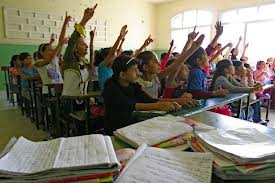 It is back to school time in Lebanon and students are finding new classmates who have fled Syria. The U.N. High Commission for Refugees says there are an estimated 20,000 Syrian refugee children attending Lebanese schools. As more Syrians cross the border, the problems of educating them become harder.
It is back to school time in Lebanon and students are finding new classmates who have fled Syria. The U.N. High Commission for Refugees says there are an estimated 20,000 Syrian refugee children attending Lebanese schools. As more Syrians cross the border, the problems of educating them become harder.
It is Friday afternoon at Averroes college in Taalabaya, Lebanon and these children are filing out, getting picked up by their parents or boarding buses to go home for the weekend.
But just a half hour later, other children fill the classroom. They are Syrian refugees and they are sharing the same building as their Lebanese counterparts, but with different courses and teachers.
Averroes College Principal Bilal Houshaymi began taking in Syrian students and teachers in August after receiving funding from two non-governmental organizations.
“We accepted at the beginning 18 teachers for 200 students, but since we started this process, we have more students and more students, we did not refuse anybody, and now we have around 350 students,” he said.
While private schools like Averroes have separate programs, public schools are mixing Syrian and Lebanese students, creating a number of logistical problems, the main one of which is curriculum, says Lebanese-Palestinian Dialogue Committee resident Khaldoun Sharif, an advisor to Lebanese Prime Minister Nagib Mikati.
“The studying program in Syria is very much different than these in our country, because in Lebanon we study in French, in English and in Arabic. In Syria, all the studies should be in Arabic,” he said.
Recently, says Sharif, the Lebanese government took several steps to accommodate Syrians, such as extending the deadline to enroll in schools and providing $130 million to fund their books.
The United Nations Refugee Agency is also helping by offering remedial classes to help Syrian students catch up. But there are more problems than a difference in education level and language says Dana Sleiman, information officer with the UNHCR.
“Many public schools are saturated in terms of capacity, so that is why we are going to provide transportation to those who do not have a school nearby that can host them,” she said.
Many of the Syrians at Averroes have witnessed extreme violence back at home, and are now living in bad conditions or working in low wage jobs, like 21-year-old Samer Maidani from Damascus.
“I felt really happy when I heard that there is a free school, because honestly, I am working now before school hours and I have to work to pay the rent for the house,” he said.
Seventeen-year-old Salam Rifaai from Homs lost her brother in the war, and longs to go back to Syria, a longing that helps her study despite what she has been through.
“I can [focus] … because … we are the people who will take over the country and build the new Syria,” he said.
Continuing their education in Lebanon is helping these refugee children get through the most difficult time in their lives, but there is no guarantee their studies will be recognized by the Syrian government when and if they return.
VOA

Leave a Reply
You must be logged in to post a comment.